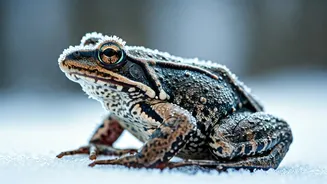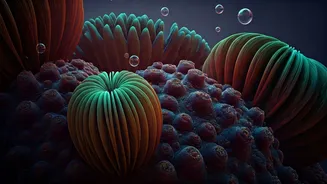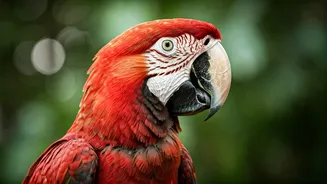The Wood Frog's Trick
The wood frog (Rana sylvatica) is a North American amphibian that shows incredible resilience. During winter, these frogs can endure freezing temperatures.
Up to 70% of their body can freeze, including their internal organs. Glucose is released from the liver into the bloodstream, acting as a cryoprotectant. This effectively prevents the formation of ice crystals within the cells, which could otherwise cause irreparable damage. When warmer weather arrives, the frogs thaw, and their bodily functions resume, ready to hop back to life. They can survive being frozen for several months, a feat of biological engineering that continues to fascinate scientists.
Amazing Painted Turtle
Painted turtles are another reptile that is able to withstand freezing conditions. These turtles are found in different parts of North America and are able to survive the winter freeze. The painted turtle can survive being frozen solid in its aquatic habitats during winter. The turtles are able to survive for several months in this condition. This process involves a combination of physiological adaptations. The turtles reduce their metabolic rate and produce cryoprotectants, like glucose, to protect their cells from ice crystal formation. Moreover, they can switch to anaerobic metabolism, which allows them to produce energy without oxygen while frozen. When the environment warms up, the turtle thaws and returns to normal activity.
The Arctic Ground Squirrel
The Arctic ground squirrel (Urocitellus parryii) resides in the frigid regions of North America. These squirrels face brutal winters. They demonstrate a remarkable ability to survive the cold. They achieve this through a process called hibernation, which involves a deep state of dormancy. During hibernation, their body temperature can drop to as low as -3°C, almost freezing. The squirrels employ a unique strategy to prevent ice crystal formation in their tissues, relying on a combination of cryoprotectants and metabolic regulation. They periodically experience brief periods of warming, allowing them to clear metabolic waste and maintain essential bodily functions. When spring arrives, these squirrels emerge, ready to resume their lives.
The Freeze-Thaw Insect
Many insect species showcase remarkable adaptations for surviving freezing conditions. Some, like certain species of beetles and flies, are freeze-tolerant. They prepare for the winter months by accumulating cryoprotectants, such as glycerol, in their body fluids. This helps to prevent the formation of damaging ice crystals within their cells. In some cases, these insects can survive being completely frozen. During the thaw, they resume their normal activity. Other insects employ freeze-avoidance strategies, seeking sheltered locations and utilizing antifreeze proteins to prevent ice formation. The specific mechanisms vary, but the result is the survival of insects in some of the coldest environments on the planet.
The Water Bear
Tardigrades, also known as water bears, are microscopic invertebrates that can withstand extreme conditions, including freezing. These tiny creatures are found in diverse habitats around the world, from mountaintops to deep-sea environments. When faced with freezing temperatures, tardigrades enter a state of cryptobiosis, a form of suspended animation. They retract their legs, contract their bodies, and replace water with a sugar called trehalose, which acts as a cryoprotectant. They can survive being frozen for years, and even decades. When conditions improve, they rehydrate and resume their activities. Their remarkable ability to withstand extreme environmental conditions makes them one of the most resilient animals on Earth.
The Antarctic Midge
The Antarctic midge (Belgica antarctica) is the world's smallest insect. It is a true survivor in one of the harshest environments on Earth. The midge has developed unique adaptations to withstand the extreme cold. It produces cryoprotective proteins that prevent the formation of ice crystals in its cells, and it can also survive being completely frozen. The midge has an extraordinary tolerance for dehydration and can survive being dried out. It can survive up to 7 years in a frozen state. The midge resumes its life cycle once conditions improve, showcasing remarkable adaptability.
The Golden-Mantled Ground Squirrel
Similar to its Arctic cousin, the golden-mantled ground squirrel (Callospermophilus lateralis) displays remarkable cold-weather resilience. Native to the mountains of North America, these squirrels hibernate to survive the winter. Their body temperature drops significantly, and their metabolic rate slows down dramatically. They enter a state of torpor. During this time, they periodically wake up to warm up and eliminate waste products. Cryoprotective molecules are used to protect their cells from damage. The ability to hibernate allows them to conserve energy and survive periods of food scarcity. When spring arrives, they emerge, ready to resume their active lives.
The European Frog
The European common frog (Rana temporaria) offers another fascinating case of freeze tolerance. They are adapted to survive in cold climates. During winter, these frogs can endure being frozen solid. They do this by accumulating high concentrations of glucose in their blood, acting as a cryoprotectant. They allow ice crystals to form outside their cells, preventing damage to the cells themselves. The frog's heart stops beating and its breathing ceases. When temperatures rise, the frogs thaw and resume their normal functions. This process demonstrates a remarkable adaptation to survive freezing temperatures and return to active life.
The Snapping Turtle's Skill
Snapping turtles (Chelydra serpentina) are known for their aggressive behavior and their impressive ability to survive in cold water environments. Snapping turtles spend the winter months in the mud at the bottom of ponds and lakes. They have the ability to remain submerged. These turtles can survive freezing conditions. They produce high concentrations of glucose in their blood. This glucose acts as a cryoprotectant, preventing ice crystal formation in their cells. They can also switch to anaerobic metabolism, allowing them to produce energy without oxygen. The snapping turtle's unique physiological adaptations enable it to survive freezing temperatures.
The Mealworm's Resilience
Mealworms, the larval stage of the darkling beetle (Tenebrio molitor), are a common insect found in many environments. These insects showcase remarkable freeze-tolerance abilities. They are known for their ability to survive cold temperatures. They prepare for freezing by accumulating glycerol and other cryoprotectants in their body fluids. This prevents the formation of damaging ice crystals within their cells. They can also regulate the freezing point of their body fluids. They can withstand temperatures well below freezing. They are able to resume their normal activities when the environment warms. The mealworm's resilience makes it a valuable species in scientific research.













